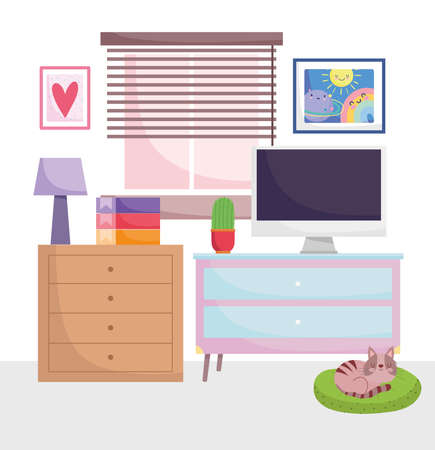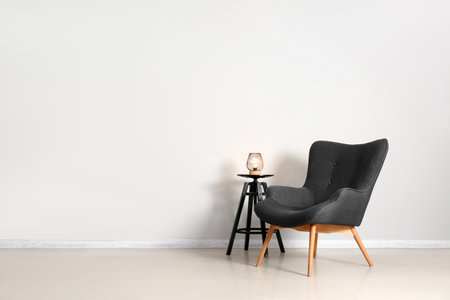1. The Essence of Minimalist Living Room Decor
Minimalism is more than just a design trend—it’s a lifestyle that embraces simplicity, functionality, and intentionality. A minimalist living room isn’t about having an empty or sterile space; instead, it focuses on creating a well-balanced environment that feels open, calming, and stylish.
Understanding the Core Principles of Minimalism
Minimalist decor revolves around a few fundamental principles that help achieve a clean and sophisticated look:
| Principle | Description |
|---|---|
| Simplicity | Keep only essential furnishings and decor to reduce clutter. |
| Functionality | Every item should serve a purpose while maintaining aesthetic appeal. |
| Neutral Color Palette | Soft tones like white, beige, gray, and earth tones create a serene atmosphere. |
| Quality Over Quantity | Invest in well-crafted pieces rather than filling the space with excess items. |
| Open Space | Avoid overcrowding by leaving enough breathing room between furniture and decor. |
Applying Minimalism to Your Living Room
To achieve a minimalist living room, start with decluttering. Remove unnecessary items and keep only those that add value or serve a function. Choose furniture with clean lines and neutral colors to create a harmonious look. Incorporate natural materials such as wood, stone, or linen for warmth and texture.
The Role of Negative Space
Negative space—empty areas around furniture and decor—is essential in minimalism. It allows each piece to stand out while giving the room an airy and uncluttered feel. Avoid overcrowding walls with excessive artwork or shelves; instead, opt for a single statement piece or carefully curated arrangement.
Balancing Aesthetics and Comfort
A minimalist living room should be both visually appealing and comfortable. Soft textiles like throw blankets, area rugs, and cushions add coziness without overwhelming the space. Selecting multi-functional furniture—such as storage ottomans or sleek media consoles—helps maintain organization while enhancing usability.
By embracing these core principles, you can create a minimalist living room that is stylish, functional, and inviting.
2. Essential Accessories for a Minimalist Living Room
Creating a minimalist living room doesn’t mean eliminating all decor—it’s about choosing the right accessories that enhance the space without adding clutter. Thoughtfully selected pieces can bring warmth, functionality, and character to your home while maintaining a clean, modern aesthetic.
Functional Furniture: Less is More
Minimalist design embraces simplicity, making functional furniture a must-have. Each piece should serve a purpose while contributing to an open and airy atmosphere. Opt for multi-functional items like storage ottomans or sleek nesting tables that help keep the space organized.
| Furniture Type | Functionality |
|---|---|
| Sleek Coffee Table | A central piece for organization with hidden storage options. |
| Modular Sofa | Adjustable seating that adapts to different layouts. |
| Floating Shelves | Adds storage without taking up floor space. |
Statement Lighting: A Subtle Yet Striking Touch
The right lighting enhances the ambiance of a minimalist living room without overwhelming the design. Choose statement lighting fixtures that complement the space while providing both style and function.
- Pendant Lights: Sleek hanging lights add sophistication without bulk.
- Floor Lamps: Tall, slim designs provide soft illumination in corners.
- Wall Sconces: Space-saving fixtures that create warm, indirect lighting.
Subtle Decorative Elements: Enhancing Without Cluttering
A minimalist living room can still feel inviting with carefully chosen decorative elements. Stick to neutral colors, natural textures, and simple designs to maintain balance.
Cushions & Throws
Select soft fabrics in muted tones to add warmth and comfort while keeping the look cohesive.
Naturally Inspired Accents
A small potted plant or dried flowers can introduce organic textures without overpowering the space.
Select Art Pieces Wisely
A single oversized artwork or a small curated gallery wall adds personality while maintaining minimalism.
The key to a successful minimalist living room is intentionality—every accessory should have a purpose and contribute to a calm, uncluttered environment. By incorporating functional furniture, statement lighting, and subtle decorative elements, you can create a space that feels stylish yet effortlessly simple.

3. Choosing the Right Artwork for a Minimalist Aesthetic
When selecting artwork for a minimalist living room, the key is to keep things simple while still making an impact. Minimalist design embraces clean lines, neutral colors, and uncluttered spaces, so your artwork should complement this aesthetic rather than overwhelm it. From abstract pieces to monochrome photography, here’s how you can choose the perfect art for your space.
Abstract Art: Adding Depth Without Clutter
Abstract art is a great choice for minimalist interiors because it allows for visual interest without excessive detail. Look for pieces with soft geometric shapes, muted tones, or a limited color palette to maintain harmony in your space. Large-scale abstract paintings can serve as a focal point without disrupting the clean aesthetic.
Monochrome Photography: Timeless and Elegant
Black and white photography fits seamlessly into a minimalist design. Whether its architectural shots, nature scenes, or artistic portraits, monochrome images add sophistication without introducing too many colors. A single framed photograph or a small curated gallery of black-and-white prints can enhance the rooms ambiance.
Framing and Placement: Keeping It Simple
The way you frame and place your artwork is just as important as the piece itself. Stick to simple frames in materials like wood or metal with thin borders to maintain a sleek look. When arranging multiple pieces, opt for symmetry or leave ample negative space around them to avoid visual clutter.
| Artwork Type | Best Fit for Minimalism | Recommended Placement |
|---|---|---|
| Abstract Paintings | Soft geometric designs, neutral colors | Main wall above sofa or fireplace |
| Monochrome Photography | B&W cityscapes, nature shots | Lined up in a grid or single large frame |
| Sculptural Wall Art | Sleek metal or wood installations | An accent wall with minimal decor around it |
Avoid Overcrowding Your Space
A minimalist living room should feel open and uncluttered, so avoid filling every wall with artwork. Instead, be intentional about placement—one statement piece can often have more impact than multiple smaller works. If you love several pieces, consider rotating them seasonally instead of displaying everything at once.
4. Color Palettes and Textures for a Minimalist Space
Creating a minimalist living room isnt just about reducing clutter—it’s also about choosing the right color palettes and textures to maintain a clean, harmonious aesthetic. A well-thought-out combination of neutral tones, natural textures, and simple patterns can enhance the sense of space and tranquility in your home.
Neutral Color Palettes
The foundation of a minimalist space is a neutral color palette. Soft whites, warm beiges, light grays, and muted earth tones help create an open and airy atmosphere. These colors not only make the room feel more spacious but also allow key design elements, such as furniture and artwork, to stand out without overwhelming the space.
| Color | Effect on Space | Best Use |
|---|---|---|
| White | Makes the room feel bright and open | Walls, ceilings, large furniture pieces |
| Beige | Adds warmth while maintaining neutrality | Sofas, rugs, accent walls |
| Gray | A modern alternative to white with depth | Cushions, curtains, statement pieces |
| Muted Earth Tones | Cultivates a grounded and calming ambiance | Bedding, decorative accents, art pieces |
The Role of Natural Textures
A minimalist living room doesn’t have to feel cold or sterile. Incorporating natural textures brings warmth and dimension to the space. Materials like linen, wool, wood, stone, and woven fibers add depth without introducing visual clutter.
Popular Natural Textures for Minimalist Decor
- Linen: Used for curtains or upholstery to create an organic feel.
- Wool: Adds softness through rugs or throws.
- Wood: Light-toned woods like oak or maple enhance warmth.
- Stone: Marble or concrete surfaces provide subtle sophistication.
- Bamboo & Woven Fibers: Perfect for baskets, lampshades, or decorative trays.
The Impact of Simple Patterns
A minimalist space benefits from subtle patterns that do not overpower the design. Instead of bold prints or busy designs, opt for soft geometric shapes, delicate lines, or monochromatic textures that blend seamlessly with the rest of the decor.
Patterened Elements to Consider
- Cushions & Throws: Choose understated stripes or tonal variations.
- An Area Rug: A textured rug with a simple pattern adds interest without distraction.
- Drapes & Curtains: Opt for sheer materials with soft woven patterns.
- A Statement Art Piece: A minimalist black-and-white print can serve as a focal point.
Selecting the right color palette and incorporating natural textures and simple patterns will help achieve a cohesive minimalist look. By keeping things balanced and understated, your living room can feel both stylish and inviting while maintaining its clean and serene aesthetic.
5. Creating a Functional and Inviting Atmosphere
Achieving a minimalist living room that feels both stylish and welcoming requires a thoughtful balance of negative space, practical design, and personal touches. By carefully selecting decor elements, arranging furniture with intention, and incorporating warmth into the space, you can create an inviting atmosphere without cluttering your home.
Balance Negative Space for a Clean Look
Negative space, or empty areas in a room, is essential in minimalist design. It helps prevent visual clutter and allows the key decor pieces to stand out. To maintain this balance:
- Avoid overcrowding furniture—opt for essential pieces that serve both function and style.
- Use neutral walls to create openness and let natural light enhance the space.
- Leave breathing room around furniture arrangements to maintain a sense of flow.
Prioritize Practical Yet Stylish Furniture
Selecting multifunctional furniture ensures your living room remains both useful and uncluttered. Consider these options:
| Furniture Piece | Functionality |
|---|---|
| Coffee Table with Storage | Keeps books, remotes, or blankets neatly stored away. |
| Sleek Floating Shelves | Adds storage without taking up floor space. |
| Modular Sofa | Easily adjustable to fit various seating needs. |
| Nesting Tables | Takes up minimal space while providing flexibility for guests. |
Add Personal Touches Without Overwhelming the Space
A minimalist living room should still reflect your personality. Incorporate subtle decorative elements that add warmth without creating clutter:
- Select meaningful artwork: Choose one or two statement art pieces rather than multiple small ones.
- Add soft textures: Use throw blankets or accent pillows in neutral tones for comfort.
- Breathe life into the space: A few well-placed indoor plants bring freshness and warmth.
- Create a cozy ambiance: Use soft lighting with table lamps or wall sconces instead of harsh overhead lights.


